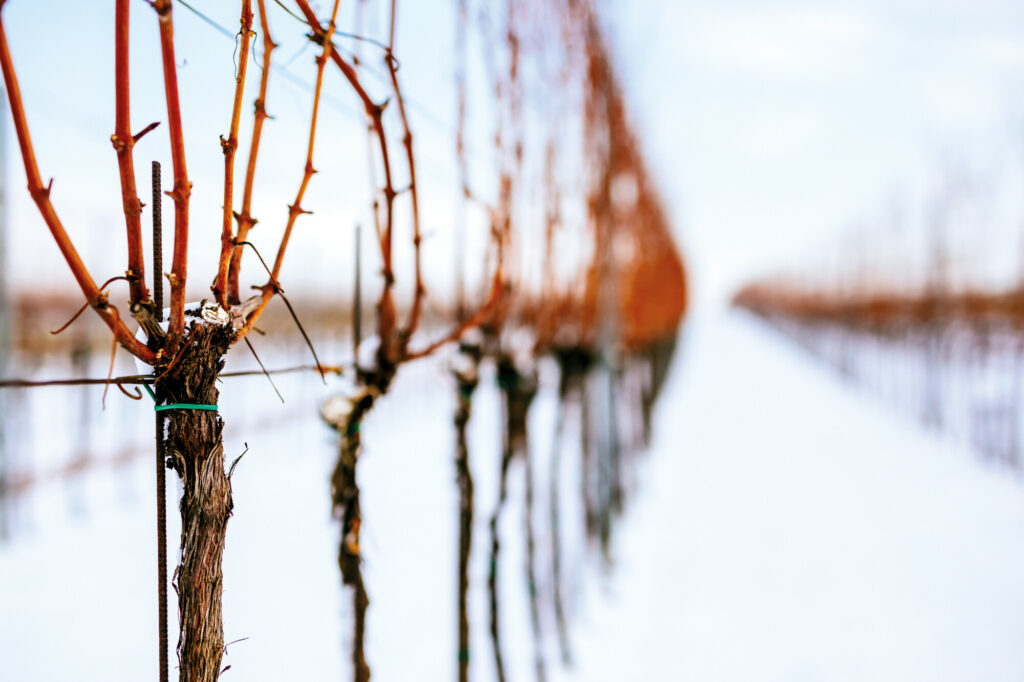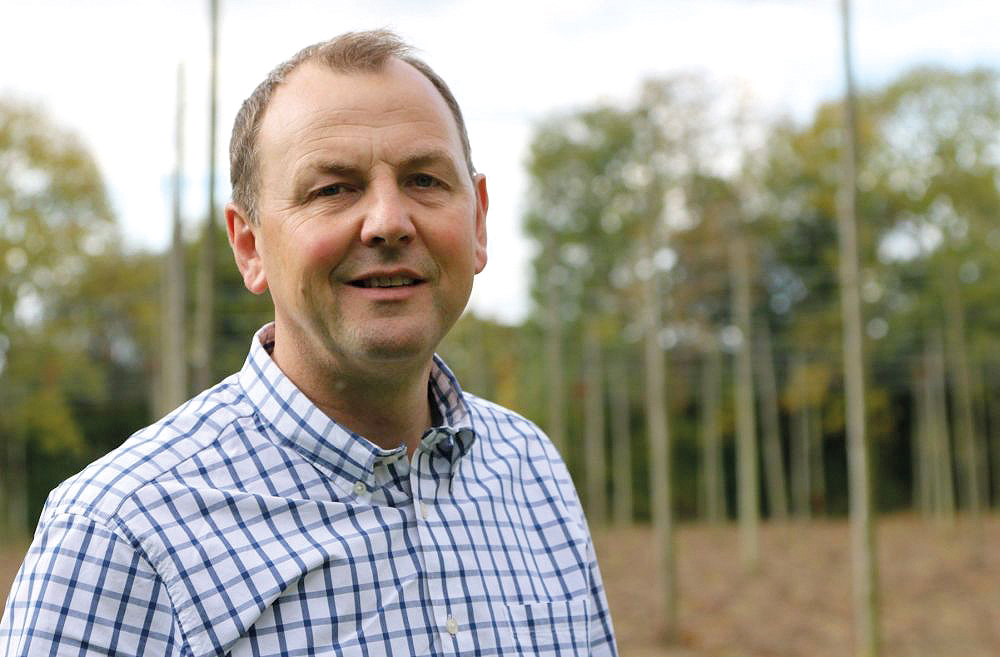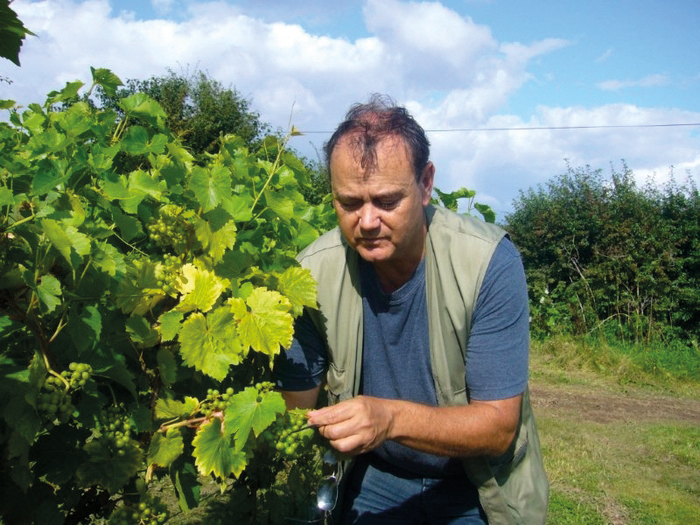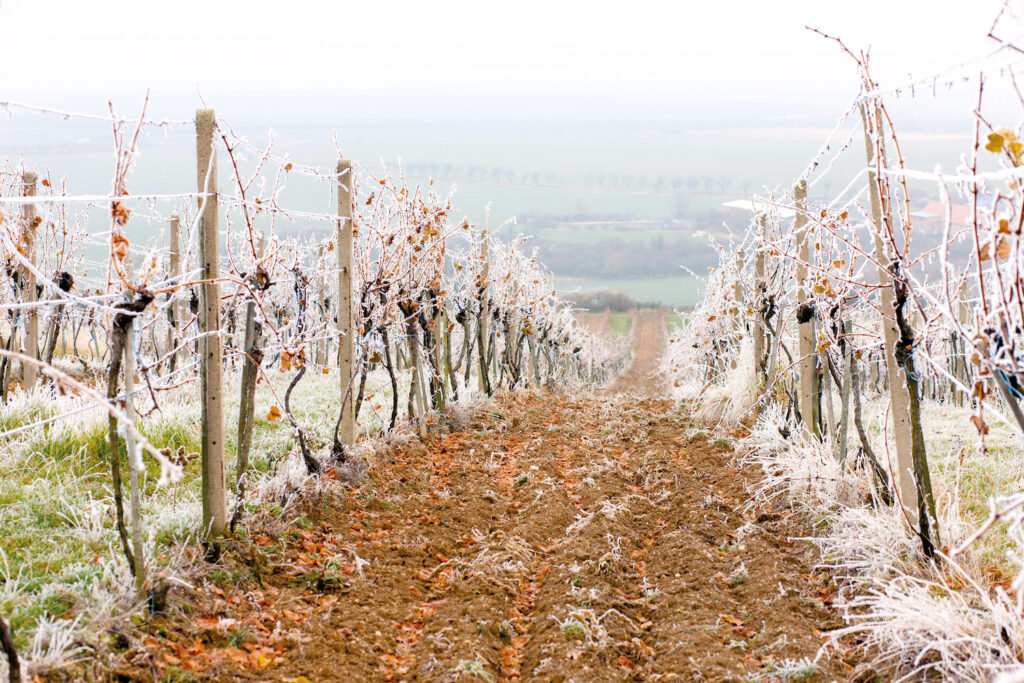Winter vineyard priorities
16th November 2022
Late autumn into winter is an ideal time to prepare vineyards for the coming season. Fruit & Vine asked Hutchinsons agronomists Rob Saunders and Chris Cooper to give their priorities during this period

Appraise canes
As autumn colours develop and leaves fall, it is a good time to assess cane growth to identify the most suitable to lay down for next season, plan pruning requirements, and highlight any problems requiring attention.
Select well-positioned canes, with appropriate bud spacing, approximately pencil-sized in diameter, healthy nut-brown colour, and free of diseases such as powdery mildew or phomopsis.
VSP (Guyot) and Scott-Henry trained canes should have reached the top wire during the year, so examine any that fell short to identify why. Common causes are poor nutrition, or soil structure issues; such as compaction, or compromised drainage.
It may be worth conducting a soil mineral nitrogen test in the new year on areas of poor vigour, as nitrogen drives strong foliar growth. Given the decent yields but stressed growing conditions of 2022, plus high fertiliser prices, there is extra need to target applications accurately.
If canes are thin and wispy (e.g. where vines carried a large crop this year), be realistic about what they can support in 2023 – it may be necessary to reduce the charge number of
buds per cane, only pruning to six rather than 12 buds, for example.

Hutchinsons agronomist, Rob Saunders.
Pruning advice
For many sites, pruning is the single biggest manual task, and deciding when to begin is a compromise between what is ideal and what is practical – depending on the area to prune and labour availability. This is why there is increased interest in mechanical pruning, chiefly tied to mechanical harvesting.
Ideally, vines should be pruned closer to the start of spring. When sap is rising and dripping after the cut is made, it is believed grapevine trunk diseases find it more difficult to colonise the wound.
Later pruning also mitigates frost risk, as tall, upright canes are less affected by ground frost, and there is more material to select from if frost damage occurs before pruning. Leaving pruning too late will result in a lot of primary bud damage, reducing quality and quantity.
Realistically though, only smaller sites, or those with plentiful labour, can leave pruning until later, and anyone reliant on contractors may have little flexibility over timing. Whenever pruning starts, try to avoid wet days which increase infection risk on cuts – dry, cold conditions are ideal.
Bud number is a useful guide to pruning. Vines grown on the Geneva Double Curtain system are typically pruned to 2–3 buds per spur, while those on the Guyot system may retain 8–12 buds per cane, and for the Scott Henry system it is nearer 5–8.
It may not always be practicable to count buds before making every cut; internodal distances are not uniform, and vary due to cultivar, rootstock, site and cultivation.
An alternative approach is to base pruning decisions on cropping potential of individual vines; considering their age, trunk diameter, vigour, length of growth, canopy area required
to be filled and general health.
It pays to be conservative when removing material, allowing more buds, leaving sacrificial canes, or delaying tying down, especially on frost-prone sites, or with frost-prone cultivars. You can always return later to trim more, rather than ending up short of material having pruned too much.
The ‘Gentle Pruning’ principles promoted by Simonit and Sirch follow a clear logic, and are gaining increased adoption in the UK.
Try to avoid making large cuts (2.5cm+), but where unavoidable, consider protecting them from disease infection while they heal. Bloccade is a useful sealant, while Solufeed Garlic Barrier has been beneficial and Vintec carries an approval with timing caveats. These can only be applied to dormant vines.

Hutchinsons agronomist, Chris Cooper.
Focus on soils
From the end of 2023, growers in England are legally required to undertake a soil test every five years. Ideally, growers should be doing so every 3–4 years. Healthy soil and balanced nutrition underpin productive vineyards.
Broad spectrum soil sampling typically every three years, combined with in-season leaf analysis, can be extremely useful for identifying potential causes of crop variability, and targeting management strategies.
Hutchinsons offers many services, including Healthy Soils Audits or Terramap high definition scanning, so speak to your agronomist or get in touch with Hutchinsons directly.
January and February are an ideal time for testing soils, as there is usually good moisture and time for remedial work and/or tailoring of fertiliser recommendations before the growing season begins or new vines are planted.
Where a broad-spectrum soil analysis has been done recently, micronutrient levels are unlikely to have materially changed; so focus pre-season testing on phosphate, potash, magnesium, pH and lime requirements.
Growers must also recognise other aspects of soil health. For example, maintaining clear ground under vines mitigates spring frost risk, but bare earth during winter reduces carbohydrate available for soil biota, and increases nutrient leaching, runoff and erosion risks.
Cover crops or mulches (either organic or biodegradable) can protect and enhance soils, while a simplistic option is to allow soil to “green up” with weed growth, providing ground cover and root growth. Generally, weeds should still be sprayed off in late winter/early spring to reduce frost risk on emerging buds in late April to early May.
Weedier sites may require a programmed approach, usually involving Kerb 400 Flo (propyzamide) in January to reduce the weed burden to a level that can be effectively controlled with a second spray in March.

Prevent disease
Good vineyard hygiene post-picking and pruning helps reduce potential disease infection of new growth next spring.
For example, downy mildew spores from fallen leaves, grapes and other infected plant material overwinter in the soil and litter layer beneath vines, so disposing of plant material will help reduce spore loading into winter.
There are logistical challenges on large sites, especially when labour availability is already under pressure.
Even where material is destroyed, rather than mulched and returned to the soil, beware inoculum often remains on canes, and decaying plant material on wires and supports, providing a potential infection bridge that needs protecting against next spring.
Enhancing soil biology could aid disease control as many fungi species act as biocontrol agents, consuming or destroying disease spores in soil.
Maintain sites
Autumn/winter is a good time to catch up on site maintenance, such as repairing trelliswork, maintaining drainage, trimming boundaries and clearing cold air channels through hedges.
For many, 2020 showed how damaging late frosts in May can be, so investing time to reduce the risks could be worthwhile.
Winter is also a key period for tackling weeds, particularly grass weeds, under vines. Due to limitations on using glyphosate in vines, in some weedier sites, consider applying Kerb Flo before the application window closes on 31st January, to control a range of weeds, following with glyphosate in spring.
Propyzamide is more persistent when applied to cold soil, but avoid delaying too long and risk missing the application window closing as travelling conditions deteriorate. Avoid applying it to saturated soils, too.
